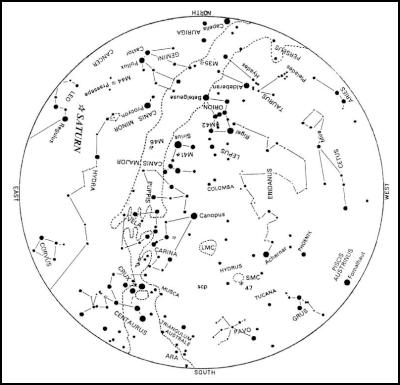The Night Sky
The Night Sky
Brian Carter *Carter Observatory
The National Observatory Of New Zealand
THE FEBRUARY NIGHT SKY
The nights are noticeable
getting longer for looking at the planets and
stars.
Planets
February is a fairly good month for viewing the planets. Venus, Saturn, Jupiter and Mars will be visible for all of the month. Only Mercury will be invisible during the month.
Venus will be visible in the evening twilight. At the start of the month it sets at 21 49 and at 21 16 by month’s end. Venus starts the month in the constellation of Aquarius, moving into Pisces on February 18 and finally into Cetus on February 28. Its magnitude increases slightly from –3.9 to –4.0 during February.
Saturn will be visible for the
whole of the night except for the very end towards the end
of the month. By February 12 it sets as the Sun rises and at
05 30 by month’s end. Saturn is in the constellation of
Leo, in which it remains until September 2009. Its magnitude
is a constant 0.0, which is its brightest for
2007.
Jupiter will be visible for the
last half of the night in February. At the start of the
month it rises at 02 04 and at 00 33 by month’s end.
Jupiter is in the constellation of Ophiuchus, in which it
remains until 2007 December. Its magnitude slightly
increases from –1.9 to –2.0 during the
month.
Mars will be visible for the
last quarter of the night. At the start of the month it
rises at 03 53 and at 03 46 by month’s end. Mars starts
the month in the constellation of Sagittarius, moving into
Capricornus on February 26. Its magnitude slightly increases
from 1.4 to 1.3 during the
month.
Mercury is visually too close to
the Sun to be seen in February. It will reappear in the
morning sky in March. Mercury starts the month in the
constellation of Capricornus, moving into Aquarius on
February 2.
All times are for Wellington
unless otherwise stated. Other centres may vary by a few
minutes.
Phases of the Moon
Full Moon –
February 2 at 18 45.
Last Quarter – February 10 at 22
51.
New Moon – February 18 at 05 14.
First Quarter
– February 24 at 20 56.
Comets
Comet C/2006
P1 (McNaught) brightened and was visible from about the
middle of January. It may still be visible into February.
Information and finding charts can be found at:
http://newsletter.carterobservatory.org/2007/Comet/
Diary of Astronomical Phenomena
Feb 2 Full
Moon at 18 45.
4 Regulus 1°S of Moon at 03 00.
8 Moon
at apogee (furthest from the Earth) at 02:00 (Distance =
0.0027072 AU = 404,990 km).
8 Mercury at greatest
Easterly elongation from the Sun (18) at 06
00.
11 Saturn at opposition (on the opposite side of the
Earth to the Sun) at 08 00.
14 Mercury stationary against
the background stars at 03 00, as its motion changes from a
Westerly to an Easterly direction.
18 New Moon at 05
14.
19 Moon at perigee (closest to the Earth) at 23:00.
(Distance = 0.0024160 AU = 361,430 km).
23 Mercury in
inferior conjunction (between the Earth and Sun) at 18
00.
FEBRUARY SKY CHART
This chart shows the sky
as it appears at about 22:00 for ~February 15.

Click to enlarge
How To Use the Sky Charts
To use the sky chart hold it up to the sky so that the direction in which you are looking is at the lower edge of the map. For example, if you are looking at the western horizon then the map should be held so that the “WEST” label is at the lower edge. The altitude and direction of the stars and planets will then be correctly shown. The centre of the chart will be directly overhead.
If you would like to receive Carter
Observatory’s full e-Newsletter, please email to
Astronomy[at]carterobservatory.org to be included on the
list.
* Brian Carter is the Senior Astronomer at Carter Observatory (The National Observatory of New Zealand), PO Box 2909, Wellington. (Observatory Web Site: www.CarterObservatory.org)


 Binoy Kampmark: The Strawman Of Antisemitism - Banning Protests Against Israel Down Under
Binoy Kampmark: The Strawman Of Antisemitism - Banning Protests Against Israel Down Under Gordon Campbell: On The Coalition’s Empty Gestures, And Abortion Refusal As The New Slavery
Gordon Campbell: On The Coalition’s Empty Gestures, And Abortion Refusal As The New Slavery Keith Rankin: Judaism, Antisemitism, And Israel
Keith Rankin: Judaism, Antisemitism, And Israel Ian Powell: Haka, Hikoi And The Empowerment Of The Kohanga Generation
Ian Powell: Haka, Hikoi And The Empowerment Of The Kohanga Generation Binoy Kampmark: Feeding Chaos - Israel Cripples Syria’s Defence
Binoy Kampmark: Feeding Chaos - Israel Cripples Syria’s Defence The Conversation: News Bargaining Incentive:
The Conversation: News Bargaining Incentive: